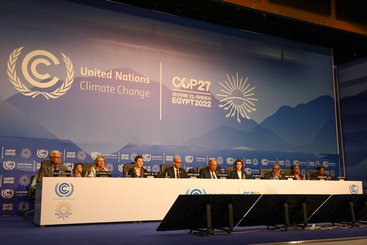An increasingly dangerous global debt burden
The looming debt crisis in low-income countries and some middle-income countries is a dark cloud over COP27 in this polycrisis world. A commonly cited statistic is that roughly 60% of low-income countries are already in or near debt distress. This includes 13 climate vulnerable countries who are struggling or expected to struggle to repay their debts.
History shows that debt crises can be a painful process for all. They threaten macro-economic stability and potentially set back a country’s development for years due to the adoption of aggressive fiscal consolidation plans involving large expenditure cuts.
Numerous factors have contributed to the dire state of affairs today, some of which predate the Covid-19 pandemic. In some countries, a key contributing factor relates to the shift towards more expensive and/or riskier sources of debt financing, largely facilitated by a prolonged period of historically low global interest rates since the 2008-2009 global financial crisis. The changing composition of government debt, however, should not be written off as a failure since in some cases it also reflects borrowing countries’ improved macro-fundamentals, increased creditworthiness, and development of their domestic debt markets.
Nonetheless, it is increasingly clear that governments, creditors and the international community have not done enough to address elevated debt risks and vulnerabilities of developing countries to exogenous shocks. The Covid-19 pandemic, rising food and energy prices, currency depreciation to the US dollar and escalating interest rates payments are creating a perfect debt storm.
Debt is not the villain in the climate crisis
In light of these growing debt vulnerabilities, it is a source of great concern that the majority of climate finance provided and mobilised by developed countries for climate action in developing countries between 2016 and 2020 is in the form of debt (72%). Grants, in contrast, account for only 26% and the remainder are equity investments.
The criticisms of debt in the climate space are two-fold. Firstly, from the public finance perspective, debts normally have to be repaid – the principal with interest. High and growing debt service burdens therefore means less fiscal space to pay for other critical government expenditures, from health, to recovering from loss and damage after a climate disaster. Last month UNAIDS warned that rising debt repayments put HIV and other health investments in danger: for every US $10 available, US $4 was spent on debt servicing and only US $1 was invested in health in 2020 in the countries that participated in the G20 Debt Service Suspension Initiative (DSSI).
Secondly, from the perspective of equity and climate justice, a climate debt is owed to developing countries by wealthy polluting nations for their role in the climate crisis. Developing countries are understandably frustrated that they should bear the costs of mitigating and adapting to a climate crisis that they didn’t cause, and argue that a much larger proportion of climate finance should therefore be provided as grants.
While these two arguments are valid in some respects, there are several nuances that needed to be carefully considered before debt is cast as the main antagonist in the unfolding climate crisis.
Footing the climate bill for mitigation, adaptation and loss and damage
The first nuance is that grants are a precious resource that will be insufficient to finance all climate actions. Given the fiscal constraints facing both the providers and recipients of grants, it is imperative that grants flow where they are most needed. In other words, funding much of adaptation and addressing the losses and damages from climate change that are beyond countries’ ability to adapt.
The underlying logic is simple: debt-financed mitigation projects to reduce emissions like the development of renewable energy, if done well, can generate cash flows or boost a country’s productive capacity so that the borrower can repay the debt. Though not impossible (think of the trillion-dollar insurance industry), this is much less straightforward for adaptation and loss and damage given limited monetised returns. Moreover, providing some proportion of scarce concessional resources as loans allows the funds to go much further, particularly if repaid and re-invested in climate action as the multilateral development banks and multilateral climate funds do.
In particular, the primary objective of loss and damage finance is to cushion the impact of climate change on those who are worst affected and have the fewest resources to cope. These communities will need grants, not loans, to recover from climate disasters through locally-owned interventions that support a range of activities such as the rebuilding of livelihoods, assisted migration in the case of sea-level rise and active remembrance following cultural losses. And while insurance mechanisms (with premiums subsidised by grants) have been the solution favoured by rich countries to date, there is growing recognition that this is not enough given the limits of insurance for addressing losses and damages that are uninsurable.
Without grants to fund recovery, climate-vulnerable countries, particularly Small Island Developing States (SIDS), will be sunk by debt. Part of the problem lies in the lack of an agreed definition of climate vulnerability and a connection back to international public finance, with several climate-vulnerable countries such as Barbados and Seychelles being regarded as too rich to be eligible for grants and concessional loans to invest in resilience.
Limited grant financing of just energy transitions should not be a deal breaker
It is within this context of competing priorities and resource constraints that international support for the just energy transition in South Africa (as well as in other carbon-intensive countries) needs to be judged.
Heralded by some observers as the crowning jewel of last year’s COP, there are some rumbles of dissatisfaction in Sharm El Sheik with how international partners – France, Germany, United Kingdom, United States, and the European Union – plan to fulfil their initial $8.5 billion pledge over the next three to five years, with grants accounting for just 4% versus concessional loans (63%), and commercial loans (18%). Assuming these loans are indeed concessional, providing South Africa with financing on cheaper terms than the market, their contribution should not be overlooked.
Furthermore, given that at the heart of the Just Energy Transition Partnership (JETP) is a country-led plan to grow the economy by reforming a highly inefficient, unreliable and dirty energy sector and spurring the development of new sectors of economic activity, it is realistic to assume that loans will be used productively and thereby facilitate their own repayments. A revitalised South African economy, with its large tax base and deep capital markets, will have the ability to repay loans, especially if not weighed down by the lumbering state-owned utility, Eskom. Grants should arguably be reserved for lower-income countries, like neighbouring Malawi, Mozambique and Zambia.
What is important is therefore whether South Africa’s investment plan is credible, containing the right mix of projects to achieve its ambitious goals, including ensuring a just transition for affected workers and communities, and with sufficient political buy-in of key domestic actors to ensure its implementation over the medium to long term. Almost all countries have infrastructure projects that were poorly designed, had large cost overruns, experienced long delays in construction, and yielded poor social dividends. The Government of South Africa as well as international partners must work together to ensure that appropriate processes are in place to ensure that financing for a just transition is used efficiently and effectively given that this is unchartered territory for several stakeholders.
Climate-compatible options for addressing debt vulnerabilities need to be prioritised
Finally, there are several climate-compatible options for addressing debt vulnerabilities, ex-ante and ex-post, that need to be designed and scaled-up. One potential game-changer is the adoption of climate-disaster clauses in all lending instruments that will enable the borrowing country to temporarily suspend debt payments if a specific event happens (based on triggers defined in the contract). This approach has been successfully piloted by Grenada and Barbados, but has yet to be adopted on a more systematic basis. A coalition of the willing, comprised of developed and developing countries, official creditors and private creditors, is critical to make this a reality.
Ultimately, demanding that developed countries provide grants for all climate actions in developing countries on the grounds of their historical responsibility is unlikely to get us far at COP27 – or indeed, on delivering the goals of the Paris Agreement. Instead, the focus should be on ensuring that providers of climate finance are directing grants to where they are most needed, utilising the complementary strengths of different financing instruments based on circumstances and opportunities, and designing innovative solutions to address the multiple gaps in the climate finance architecture. For further insights on the potential of different financing instruments, please see our working paper: Using the right mix of financial instruments to provide and mobilize climate finance.
In the last few years, the conversations within the climate deliberations have not proven so nuanced or far-sighted. The current stand-off is perhaps understandable given unmet promises and new crises. Until developed countries provide and mobilise the long-promised $100 billion, it looks unlikely that negotiators will be able to have a constructive dialogue about what a good climate finance system looks like.



